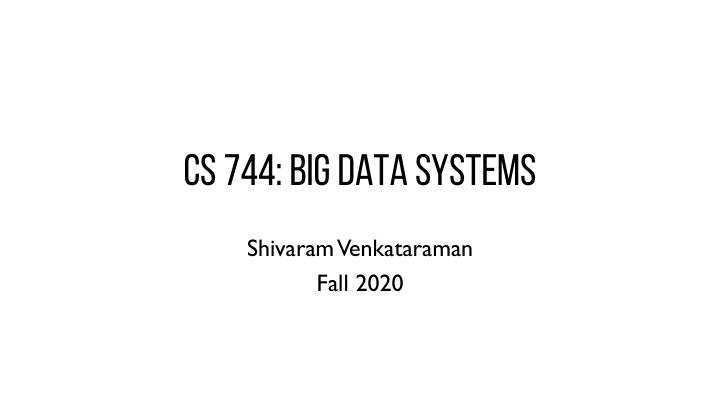



CS 744: Big Data Systems Shivaram Venkataraman Fall 2020
Who am I ? Assistant Professor in Computer Science PhD at UC Berkeley: System Design for Large Scale Machine Learning Industry: Google, Microsoft Research Open source: Apache Spark committer Call Me: Shivaram or Prof. Shivaram
COURSE LOGISTICS Shivaram Venkataraman Office hours:Tuesday 11-noon, BBCollaborate TA: Saurabh Agarwal Office hours: Wed 3-4pm, BBCollaborate Discussion, Questions: Use Piazza!
TODAYS AGENDA What is this course about? Why are we studying Big Data systems? What will you do in this course?
BRIEF HISTORY oF BIG DATA
Google 1997
Data, Data, Data “…Storage space must be used efficiently to store indices and, optionally, the documents themselves. The indexing system must process hundreds of gigabytes of data efficiently…”
Google 2001 Commodity CPUs Lots of disks Low bandwidth network Cheap !
Datacenter Evolution 15 Moore's Law 10 Facebook’s daily logs: 60 TB Overall Data 5 Google web index: 10+ PB 0 2010 2011 2012 2013 2014 2015 (IDC report*)
“scientific breakthroughs will be powered by advanced computing capabilities that help researchers manipulate and explore massive datasets” -- Jim Gray
GRAVITY WAVE DETECTION
SOLAR FLARE prediction ~ 2 PB Working with data from Solar Dynamics Observatory [Brown et. al SDO Primer 2010] Solar Flare Prediction Using Photospheric and Coronal Image Data. [Jonas et. al American Geophysical Union, 2016]
18( Graph(based(on( 16( average(growth( Detector( 14( Sequencer( 12( Processor( Memory( 10( 8( 6( 4( 2( 0( 2010( 2011( 2012( 2013( 2014( 2015( Source: More Data, More Science and... Moore’s Law [Kathy Yellick ]
Datacenter Evolution Google data centers in The Dulles, Oregon
Datacenter Evolution Capacity: ~10000 machines Bandwidth: Latency: 12-24 disks per node 256GB RAM cache
Jeff Dean @ Google
How do we program this ?
BIG DATA SYSTEMS
Applications Machine Learning SQL Streaming Graph Computational Engines Scalable Storage Systems Resource Management Datacenter Architecture
Course syllabus
WHICH TIMEZONE ARE YOU WORKING FROM? >90% are in Central ~few in Pacific ~few other time zones
What do you hope to learn from the course? Learn about the design decisions and challenges involved in building big data systems… How to efficiently read a paper, how to write a paper through the project, learn more about big data stacks… To get a better sense of what it covers. It sounds like a totally new (but interesting) field to… I am interested in ML and would like to gain experience in dealing with large datasets. To get a practical sense of how big data systems work, understand theoretical concepts…
LEARNING OBJECTIVES At the end of the course you will be able to • Explain the design and architecture of big data systems • Compare, contrast and evaluate research papers • Develop and deploy applications on existing frameworks • Design, articulate and report new research ideas
LEARNING OBJECTIVES At the end of the course you will be able to • Explain the design and architecture of big data systems Paper Review • Compare, contrast and evaluate research papers Discussion • Develop and deploy applications on existing frameworks Assignment • Design, articulate and report new research ideas Project
CLASS Format Schedule: http://cs.wisc.edu/~shivaram/cs744-fa20 Reading: ~1 paper per class Review: Fill out review form (link posted on Piazza) by 9am Discussion: In-class group discussion, submit responses within 24 hours (Best 15 out of 20 responses for both)
HOW TO READ A PAPER: EXAMPLE
PRACTICE DISCUSSION! https://forms.gle/oiWGjujBJG8iEwDS6
PRACTICE DISCUSSION SUMMARY
ASSESSMENT Paper reviews: 10% • Class Participation, Discussion: 10% • Assignments (in groups): 20% (2 @ 10% each) • Midterm exams: 30% (2 @15% each) • Final Project (in groups): 30% •
Assignments Two homework assignments in Python using NSF CloudLab - Assignment 0: Setup CloudLab account - Assignment 1: Data Processing - Assignment 2: Machine Learning Short coding based assignments. Preparation for course project Work in groups of three
EXAMS Two midterm exams • Open book, open notes • Mostly synchronous • • Focus on design, trade-offs More details soon
Course Project Main grading component in the course! Explore new research ideas or significant implementation of Big Data systems Research: Work towards workshop/conference paper Implementation: Work towards open source contribution
COURSE PROJECT EXAMPLES Example: Research How do we scheduling distributed machine learning jobs while accounting for performance, efficiency, convergence ? Example: Implementation Implement a new module in Apache YARN that allows GPUs to be allocated to machine learning jobs.
Course PROJECT Project Selection: - List of course project ideas posted - Form groups of three - Bid for one or more ideas or propose your own! - Instructor feedback/finalize idea Assessment: - Project introduction write up - Mid-semester check-in Peer Review! - Poster presentation - Final project report
WAITLIST - Class size is limited to 75 for this semester - Focus on research projects, discussion - Limited undergraduate seats If you are enrolled but don ’ t want to take, please drop ASAP! If you are on the waitlist and have a pressing case, send me an email If you want to audit the class:
BEFORE NEXT CLASS Join Piazza: https://piazza.com/wisc/fall2020/cs744 Complete Assignment 0 (see website) Paper Reading: The Datacenter as a Computer
Recommend
More recommend